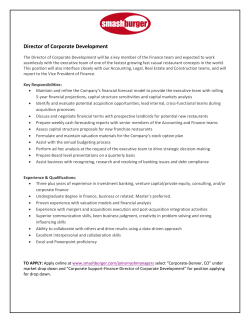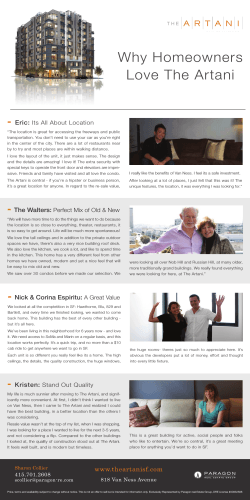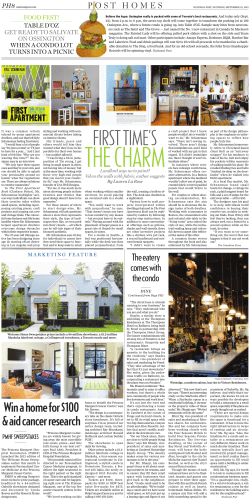
4-1-15 Successful Restaurants - Berkeley
Successful Restaurants Alameda County SBDC Berkeley Public Library April 1, 2015 Thank you to Our Sponsors Who is the SBDC? Partnership SBDCs stimulate sustainable economic prosperity throughout coastal Northern California and the greater San Francisco Bay area. Through world class, transformative business counseling and training, we assist entrepreneurs with solutions for more profitable business management to thrive in today’s global market The purpose of the Oakland Metropolitan Chamber of Commerce is to promote commerce and industry, to advance economic growth Our Services Free One-on-One Consulting Free & Low cost Seminars Seminar Examples Access to Capital Successful Business Plans Starting a Business Meet the Lenders Social Media Government Contracts Marketing Law for Entrepreneurs Retailing Buying a Business Starting a Restaurant Crowdfunding and Alternatives Starting a Food Business How to Pitch Your Company Finding Your Core Customer eMarketing Website Development Home Based Businesses ACSBDC Consultants Ron Barrett Loan Specialist Ed Duarte Construction David Bokash Web Technology David Gray Food and Restaurants FJ Cava Generalist Tara Lynn Gray Crowdfunding Deb Doyle Branding Carolyn Johnson Business Plans ACSBDC Consultants Vaneese Johnson Marketing David Mitroff Social Media Bob Komoto Export/Import Mari Lovalvo Human Resources Paula Mattisonsierrra Retail Dorian Webb Operations Deagon Williams Food & Restaurants Tom Yeh Strategy How to register for services www.acsbdc.org Technology Initiative o Focuses on qualified technology companies. o Assists with the commercialization of technology and preparing for fund raising o No fees for its services and takes no ownership interest. o Goal is to help technology companies start, grow and thrive Are we effective? • SBDCs are required to track and measure results o o o o o o New Business Starts Jobs Created Jobs Retained Increases in Sales New Loans Secured New Equity Capital Secured ACSBDC 2012 – 2014 Economic Impact 1,490 Companies Counseled 5,118 Seminar Attendees 95 Business Starts 502 Jobs $20.1 MM Revenue Generated $27.6 MM Loans Secured $39.4 MM Equity Invested Please complete the Evaluation form at the end Presentation Download www.acsbdc.org/handouts Deagon B Williams o o o o Classically trained chef with 20+ years industry experience. Culinary Business Strategy- principal SBDC since 2009 Specializes in the bringing the business side to culinary ventures and organizations. 15 Successful Restaurants What do you want out of this seminar? Successful Restaurants: Concept The most valuable component of a successful restaurant is creating, defining and refining your concept to ensure it works. • RP5 • Market Opportunity or • Creating Market Opportunity • The answer to this will determine how you get from A-Z • 5 years backwards is a good start Concept Specifics • Design • Décor • • • • • • Menu/Food Price Location Personnel etc. Financials Marketing How do all the ideal pieces fit? Can you afford to pay people to help you grow this business? Ultimately this becomes your brand. Concept Components – If someone were to lend you $100,000 tomorrow towards your business, would you be confident in knowing how to spend it and how to pay it back? Concept: Price – Price – Research every element until you’re sure this is worth devoting your life to: • • • • • Recipes/Menu, Market and customer profiles, Operations (Front and Back of House systems), Sales goals, Competition, etc. Concept: Product – Product • Based on research, based on passion? • Infrastructure of building. TI, Façade, kitchen upgrades • Do you have a designer and GC? Can you afford them now? • Understanding and making use of financial statement in the food business Concept: Place – Place - Know the Target Market • Demographics - Who are your customer types? • What do they do, eat, drink, shop, wear and live? • How do you reach them, sell to them, engage them and keep them coming back for more? Concept: Promotion – Promotion • Is there a way to begin to create promotional campaigns before you get into a brick and mortar location? • Pop-ups, catering, and food trucks and carts are a great way to get started with limited. • Here is a great resource (http://www.sfcartproject.com/) if you’re interested in starting a mobile food business. Positioning Statement A positioning statement has 3 components: 1. Defines the target audience 2. States the category in which brand competes 3. Points out the benefit over other brands Ex.: For upscale American families, Volvo is the family automobile that offers maximum safety. Positioning Statement Formula If you are stuck building your statement, try this formula: “ For (target customer) who (statement of the need or opportunity), the (product name) is a (product category) that (statement of key benefit – that is, compelling reason to buy).” Business Plan • You don’t build a house without architectural plans, why would you invest your life and savings into something without having the foundational piece. B Plan Formula: Success Mission Customer Competition Costs Product Pricing Promotion Physical Distribution People Money Business Plan • • • Constantly tinker with your business plan. It is never completed. Rather, it’s an evolving document which grows with your business. – All Food Business http://www.allfoodbusiness.com/starting_your_own_busine ss.php – BPlans http://www.bplans.com/fast_food_restaurant_business_pla n/executive_summary_fc.php#.UGndv0TGI7t Success on the ground A plan that becomes a system Systems, Systems and Systems! Yes, really. Consistency and kindness- hand in hand Execute with a vision Financial Success If you don’t know your numbers, you don’t know your business! If you aren’t getting paid it’s not a business it’s a hobby. It is all about relationships to get the big picture. What are common problems? Inventory Hourly Labor Purchasing practices Prime Cost Includes cost of sales (food, beverage and paper goods in quick-serve restaurants) Payroll costs (gross wages of management and hourly staff plus payroll taxes and employee benefits such as workers' compensation and employee insurance) www.restaurantowner.com/primecostworksheet primecostworksheet3.xls primecostworksheet Breakeven Point To calculate your Break Even Point you must know your total fixed expenses, your total planned variable expenses and your planned net sales. Let’s talk about it… Formula: Fixed Costs / (1-(Variable Costs/Sales)) http://www.docstoc.com/docs/82061341/Break-EvenPoint-Calculation-Template-for-Restaurants Monthly Profit and Loss Sales Cost of Sales Payroll Controllable Expenses (Variable Costs) Direct Operating Expenses (Fixed costs) End of month cash on hand does not equal profit. Food Cost Also known as cost of goods sold (COGS) What does it cost to make each product you sell? PB&J Front load costs Yileds http://www.wikihow.com/Cost-a-Recipe And, it’s ALL about the food Know your product better than anything: –Consistency, –Price, –Taste, –Quality, etc. Recipe book Secondary uses of product Portion Control Food Safety TASTE everything! Make it a standard. Employees and People Let’s talk about this… Job descriptions HR manual Marketing starts here Branded Marketing It’s the air we breathe! It is not sales and marketing- sales AND marketing Marketing is also not a tactic- please know this. Please. Let’s go back to the concept for a moment- You…. Pay yourself. Period. Schedule your time. Know every job in your business. Get help where you need it. Have a plan for your time and your business. Revisit your business plan and adjust it. Measure- what gets measured gets done. Questions What do you want more of? What didn’t get answered? What do you need? How are you going to get there? THANKS EVERYONE
© Copyright 2026





















